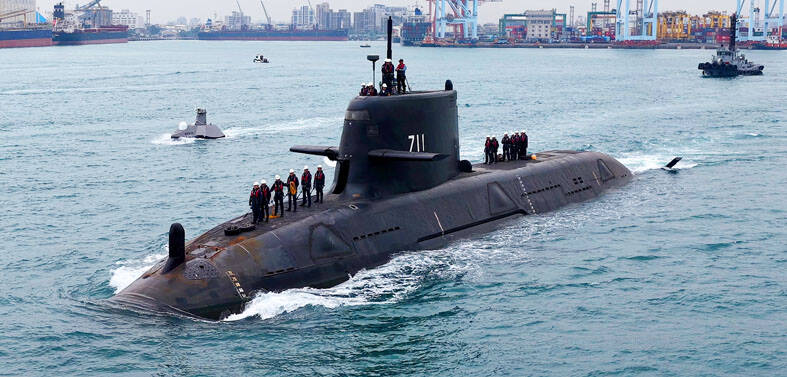The effectiveness of Taiwan’s fast-attack missile boats to counter the Chinese military will largely depend on the vessels’ ability to acquire targeting information, which might not be guaranteed in a full-scale war scenario, a defense expert said recently.
Unable to compete with the People’s Liberation Army Navy on a tonne-for-tonne basis, the Taiwanese Navy has in recent years embarked on an “asymmetrical” program, developing and fielding fast-attack boats equipped with a variety of surface-to-surface and anti-ship missiles.
Since 2010, three squadrons, or a total of 31 170-tonne Kuang Hua VI fast-attack missile boats, have entered service in the navy. Each boat is equipped with four Hsiung Feng II (HF-2) anti-ship missiles, which have a range of approximately 150km.
Since last year, the military has also begun modifications on some of its 500-tonne Ching Chiang-class patrol boats to outfit them with four Hsiung Feng III (HF-3) ramjet-powered supersonic anti-ship missile launchers. Five Cheng Kung-class frigates have also been outfitted with HF-3s as part of a NT$12 billion (US$406 million) program to arm the navy with 120 HF-3s, a 300km-range missile that since last year has been known as Taiwan’s “carrier killer.”
A new 450-tonne radar-evading fast attack corvette currently under development under a program known as “Hsun Hai,” or “Swift Sea,” is expected to be outfitted with eight HF-2 and HF-3 launchers.
Late last month, Chinese Nationalist Party (KMT) Legislator Lin Yu-fang (林郁方) told a meeting of the legislature’s Foreign and National Defense Committee that Hsun Hai vessels equipped with 650km-range HF-2Es would give Taiwan the ability to launch retaliatory attacks on Chinese military targets well beyond coastal areas.
The Hsiung Feng missile is produced by the Chung Shan Institute of Science and Technology. Taiwan’s development of cruise missile technology has proceeded despite opposition from the US, especially over the HF-2E, which Washington considers an offensive weapon.
Despite the missile boats being hailed as an effective way to counter China, some defense experts have said that the vessels’ reliance on off-board sensors for over-the-horizon (OTH) targeting to fully exploit the reach of their missiles could be their Achilles’ heel.
Those off-board sensors include AN-TPS-59 radars, which have a range of 740km and a variety of phased-array radars installed near missile bases.
AN-TPS-59 and 445km-range AN/TPS-75V radars are installed on Dongyin Island (東引島) of the Matsu island chain, just 45km off the coast of China’s Fujian Province. Defense News reported in 2010 that the radars bring Fuzhou Air Base and Longtian Air Base within their coverage, as well as the Nanping Missile Base and Xianyou Missile Base, where Dong Feng-15 ballistic missiles are deployed. The recently completed Shuimen Air Base is also within range.
Dongyin, as well as other shore-based radar sites on Taiwan’s offshore islands and Taiwan proper, would likely be among the primary targets of an attack by China.
“The true measure of effectiveness of the asymmetrical capabilities [of the fast-attack missile boats] rests with the robustness and survivability of the principally shore-based long-range radar network and the tactical datalink system,” a US-based defense expert told the Taipei Times recently, adding that it was far from certain whether such systems would remain viable in a full-scale war scenario.
Unlike China, the Taiwanese military does not have a -constellation of surveillance and tracking satellites, such as the Beidou navigation system, to provide homing coordinates for its cruise missiles. As such, by disabling the long-range radars or datalink systems used by the Taiwanese Navy to provide targeting information to the vessels, China could make it impossible for Taiwanese attack boats to effectively use their cruise missiles for OTH attacks on targets in China or at sea, thus negating the asymmetrical advantage.
Although unmanned aerial vehicles (UAV) can provide an alternative guidance and datalink platform, Taiwan is not known to have developed survivable mobile command-and-control centers that could receive information from UAV sensors or from a ground station and then assign target data to missile-carrying platforms at sea, the source said.
Another source told the Times yesterday that mobile radar systems, which the Taiwanese military possesses, would have better chances of evading or surviving at attack.
Taiwan has also reportedly shown interest in acquiring low-probability-of-intercept radars (LPIR), which are designed to be difficult to detect while tracking a target, the source said.

US climber Alex Honnold is to attempt to scale Taipei 101 without a rope and harness in a live Netflix special on Jan. 24, the streaming platform announced on Wednesday. Accounting for the time difference, the two-hour broadcast of Honnold’s climb, called Skyscraper Live, is to air on Jan. 23 in the US, Netflix said in a statement. Honnold, 40, was the first person ever to free solo climb the 900m El Capitan rock formation in Yosemite National Park — a feat that was recorded and later made into the 2018 documentary film Free Solo. Netflix previewed Skyscraper Live in October, after videos

NUMBERS IMBALANCE: More than 4 million Taiwanese have visited China this year, while only about half a million Chinese have visited here Beijing has yet to respond to Taiwan’s requests for negotiation over matters related to the recovery of cross-strait tourism, the Tourism Administration said yesterday. Taiwan’s tourism authority issued the statement after Chinese-language daily the China Times reported yesterday that the government’s policy of banning group tours to China does not stop Taiwanese from visiting the country. As of October, more than 4.2 million had traveled to China this year, exceeding last year. Beijing estimated the number of Taiwanese tourists in China could reach 4.5 million this year. By contrast, only 500,000 Chinese tourists are expected in Taiwan, the report said. The report

Temperatures are forecast to drop steadily as a continental cold air mass moves across Taiwan, with some areas also likely to see heavy rainfall, the Central Weather Administration (CWA) said. From today through early tomorrow, a cold air mass would keep temperatures low across central and northern Taiwan, and the eastern half of Taiwan proper, with isolated brief showers forecast along Keelung’s north coast, Taipei and New Taipei City’s mountainous areas and eastern Taiwan, it said. Lows of 11°C to 15°C are forecast in central and northern Taiwan, Yilan County, and the outlying Kinmen and Lienchiang (Matsu) counties, and 14°C to 17°C

STEERING FAILURE: The first boat of its class is experiencing teething issues as it readies for acceptance by the navy, according to a recent story about rudder failure The Hai Kun (海鯤), the nation’s first locally built submarine, allegedly suffered a total failure of stern hydraulic systems during the second round of sea acceptance trials on June 26, and sailors were forced to manually operate the X-rudder to turn the submarine and return to port, news Web site Mirror Daily reported yesterday. The report said that tugboats following the Hai Kun assisted the submarine in avoiding collisions with other ships due to the X-rudder malfunctioning. At the time of the report, the submarine had completed its trials and was scheduled to begin diving and surfacing tests in shallow areas. The X-rudder,